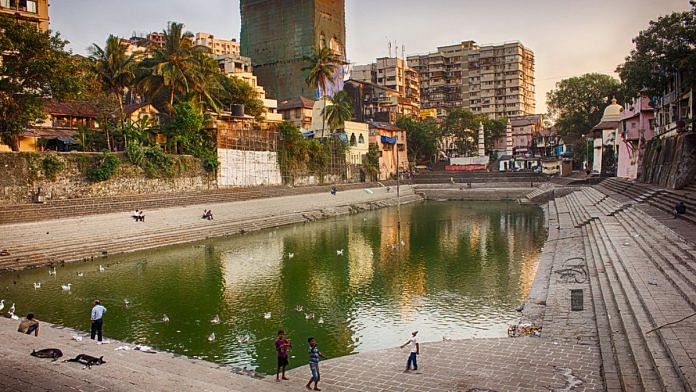Mumbai: The Brihanmumbai Municipal Corporation (BMC) in Mumbai, along with the Gaud Saraswat Brahmin Temple Trust (GSBTT), are planning to renovate the Banganga Tank, a heritage precinct in the city’s upmarket Walkeshwar area to attract tourists and devotees.
The project, which was inaugurated by tourism minister Mangal Prabhat Lodha last week, is expected to be completed in six months and will cost around Rs 12 crore, of which Rs 6 crore will be borne by BMC, said Sharad Ughade, assistant commissioner, D-ward, BMC, under whose purview this project is being implemented.
The Banganga Tank is a 12th-century rectangular step-water tank, similar to the ghats in Varanasi. It houses a 12th-century Ram kund (Ram’s pond), which is currently buried under debris. The project aims to restore the heritage look, revive the Ram kund, clear the encroachments, and build public facilities in the area.
The legend goes that when Ram and Laxman went searching for Sita, they came to the spot where Banganga is located. To quench their thirst, Ram shot an arrow (baan in Marathi) into the ground and water emerged from within. This is how Banganga got its name.
“This is Mumbai’s heritage that needs to be restored. Thousands of devotees visit the place and that is why we must restore it,” Ughade told ThePrint Wednesday.
The proposed plan
Speaking to ThePrint, Ughade said, the Ram kund is currently hidden under debris and the aim is to uncover and restore it. “We have received permission for restoration from the GSB trust and the state archaeology department, but it will take a while. First, we are restoring the Banganga tank,” Ughade said.
The tank is a grade-1 heritage precinct that is privately owned by the GSBTT and maintained by the state archaeology department. According to ministry of housing and urban affairs, heritage grade-I category comprises “buildings and precincts of national or historic importance, embodying excellence in architectural style, design, technology and material usage”.
It is also known for its religious significance, as it draws around 10,000 devotees on Kartik Purnima and during Pitru Paksha, for ‘pind daan’ (a ritual offering homage to a departed soul).
The main steps of the renovated tank will have niches for diyas, which are currently missing, to resemble the Varanasi ghats. There will also be a bracket for light on the main wall, according to BMC.
The aquatic life in the tank — a natural waterbody and a source of freshwater in Mumbai despite being close to the Arabian Sea — will also be revived.
According to BMC, the proposed plan also includes clearing encroachments around the area, building public facilities, and creating a separate area for religious activities.
There are some prominent temples in the vicinity, such as Kashi and Kavale Math, which will also be refurbished and beautified, said Ughade. The BMC will use stone steps with brackets for brass bells, carved wooden doors and windows in the renovation. The temples will also have wooden boards with their names on them.
The plan includes having murals and stone structures along the wall that houses the structure, while the exterior facade of the residential buildings in the area will be painted in a uniform colour.
According to the plan, the stone steps will have wooden railings and stone structures on the sides for visitors to rest. The staircases will have heritage light poles with integrated signage. The viewing points will have interactive seating with green spaces and cobblestone flooring and will be illuminated with heritage light poles.
He added that the approach road and others nearby will also be improved
The encroachers and hutments along the area will be relocated nearby, without increasing the cost of the project, said Ughade. Similar to in Varanasi, the project will also create open public spaces, promenades, and gardens, he added.
“For religious activities, since there will be a dedicated area, cleanliness around the entire area will be maintained. I think things will improve drastically,” Ughade said.
(Edited by Richa Mishra)
Also Read: Mumbai doesn’t want to become Delhi. BMC, Bombay High court crack down on AQI




How did you miss Shri Parshuram temple? It may the only temple or one among few.